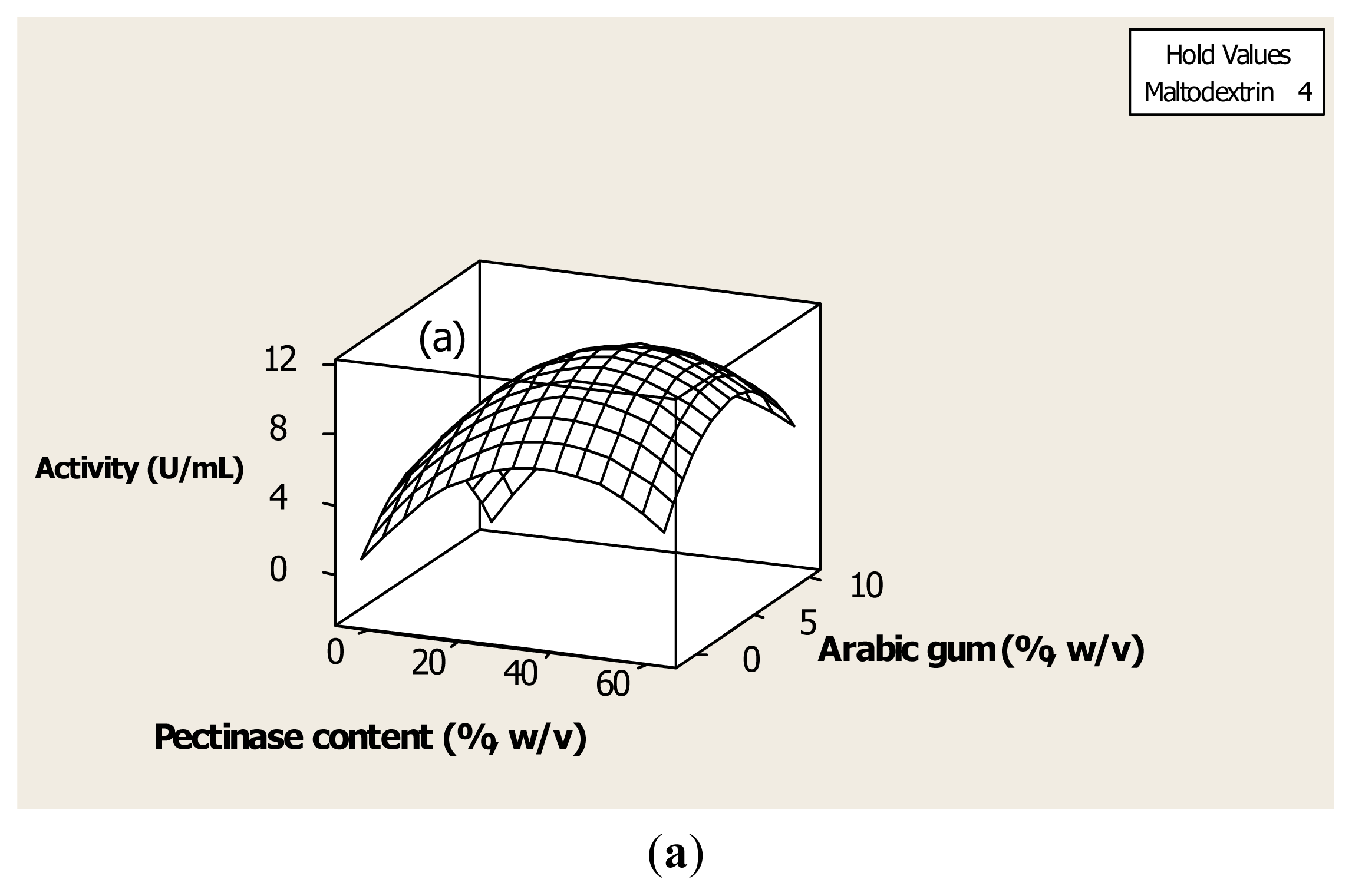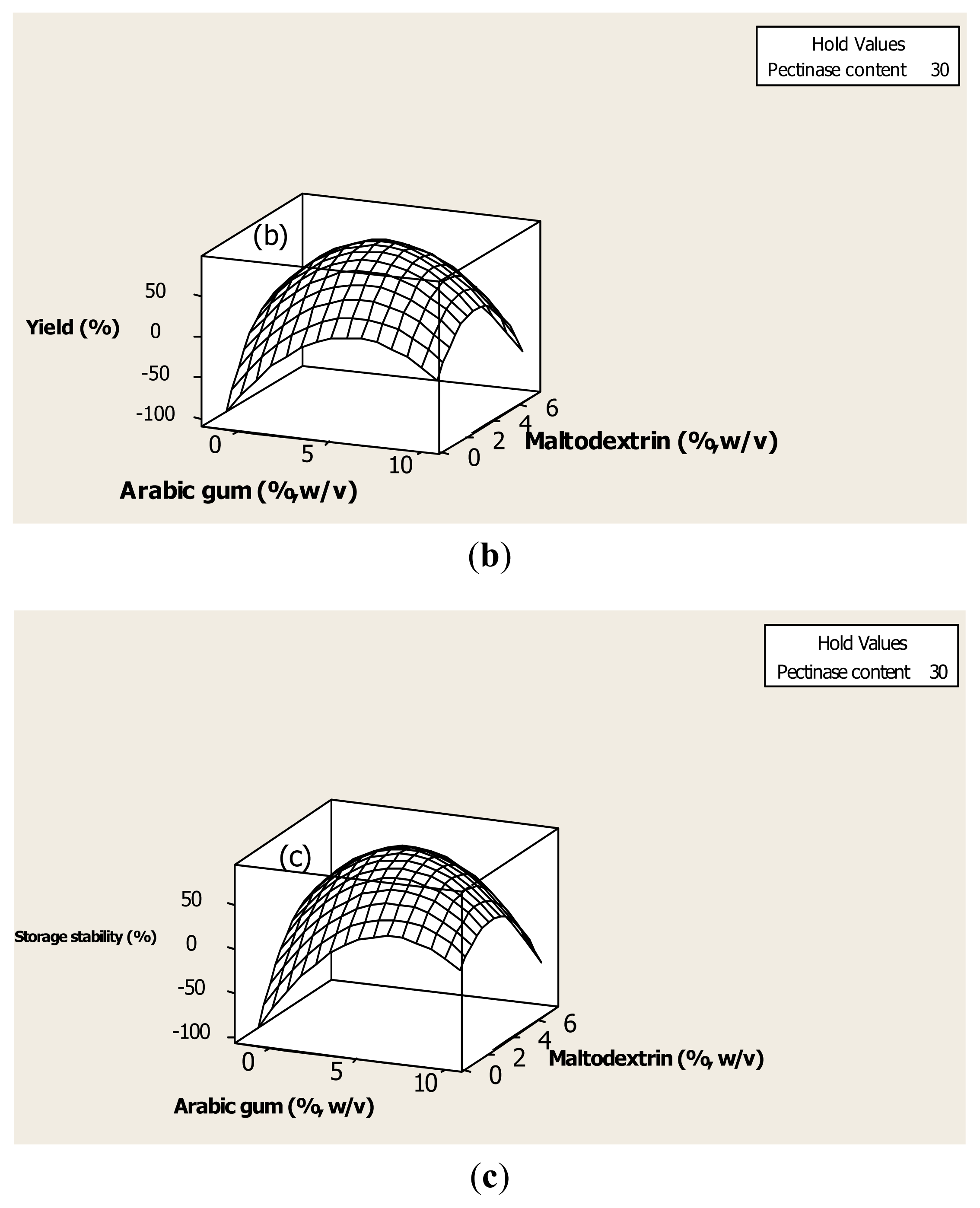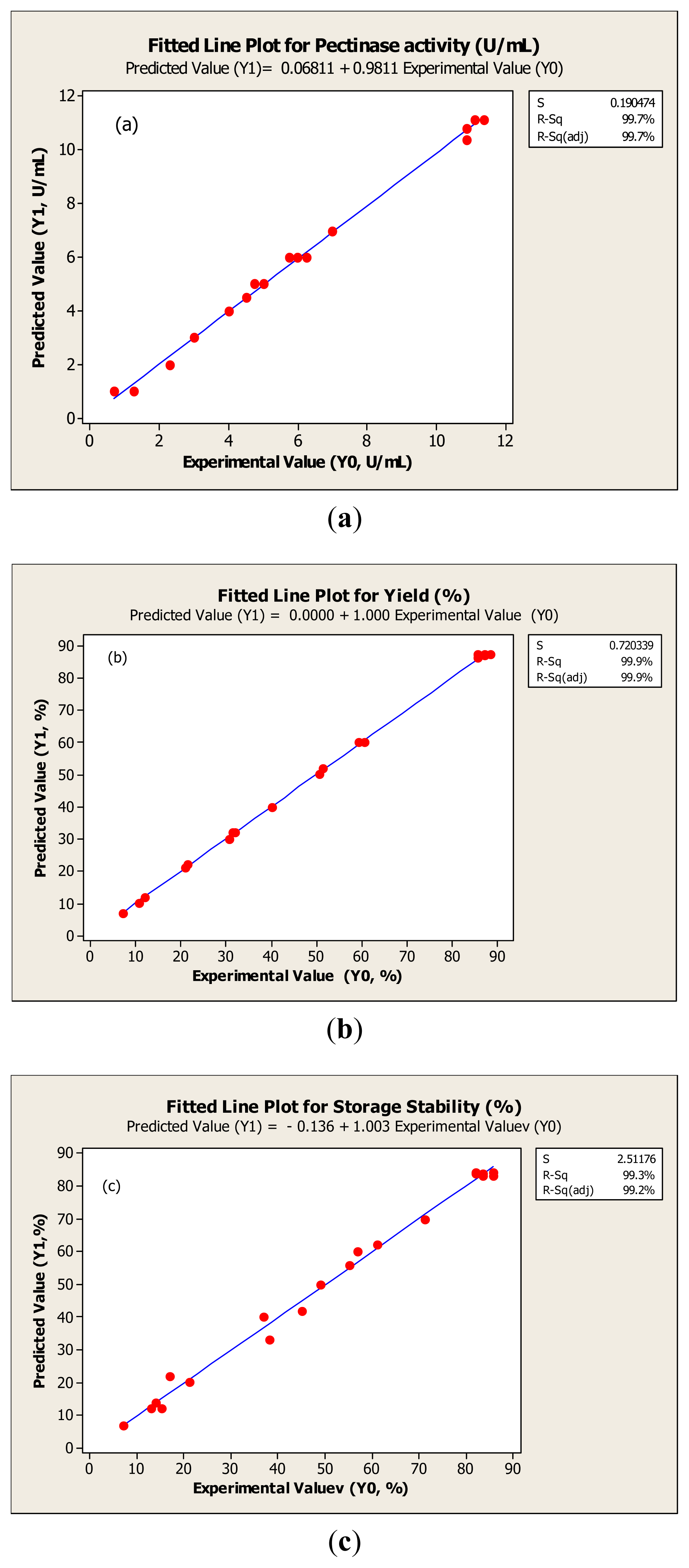Optimization of Freeze Drying Conditions for Purified Pectinase from Mango (Mangifera indica cv. Chokanan) Peel
Abstract
:1. Introduction
2. Results and Discussions
2.1. Response Surface Analysis
2.2. Activity of Pectinase
2.3. Yield of Pectinase
2.4. Storage Stability of Pectinase
2.5. Optimization Procedure
2.6. Validation of Model
3. Experimental Section
3.1. Material
3.2. Preparation of Feedstock
3.3. Purification of Crude Extract
3.4. Freeze Drying of Pectinase
3.5. Pectinas Activity Assay
3.6. Yield
3.7. Storage Stability
3.8. Statistic Design
4. Conclusions
References
- Food and Agriculture Organization, FAO Products Year Report; Food and Agriculture Organization: Rome, Italy, 2005.
- Popenoe, W. Manual of Tropical and Subtropical Fruits; Macmillan Co: New York, NY, USA, 1920. [Google Scholar]
- Ajila, C.M.; Bhat, S.G.; Prasada Rao, U.J.S. Valuable components of raw and ripe peels from two Indian mango varieties. Food Chem 2007, 102, 1006–1011. [Google Scholar]
- Amid, M.; Ping, T.C.; Mirhosseini, H.; Norashikin, A.; Chuan, L.T. Optimisation of serine protease extraction from mango peel (Mangifera Indica cv. Chokanan). Food Chem 2011, 124, 666–671. [Google Scholar]
- Kashyap, D.R.; Vohra, P.K.; Chopra, S.; Tewari, R. Applications of pectinases in the commercial sector: A review. Bioresour. Technol 2001, 77, 215–227. [Google Scholar]
- Manning, M.C.; Patel, K.; Borchardt, R.T. Stability of protein pharmaceuticals. Pharm. Res 1989, 11, 903–918. [Google Scholar]
- Geigert, J. Overview of the stability and handling of recombinant protein drugs. J. Parenter. Sci. Technol 1989, 43, 220–224. [Google Scholar]
- Risch, S.J. Encapsulation: Overview of Uses and Techniques; Science by Design: Edina, MN, USA, 1995. [Google Scholar]
- Yasui, T.; Hashimoto, Y. Effect of freeze-drying on denaturation of myosin from rabbit skeletal muscle. Food Sci 1966, 31, 293–299. [Google Scholar]
- Yu, N.; Jo, B.H.; Liu, C.S. A laser Ramam spectroscopic study of the effect of solvation on the conformation of ribonuclease A. J. Am. Chem. Soc 1972, 94, 7572–7575. [Google Scholar]
- Hanafusa, N. Denaturation of Enzyme Protein by Freeze-Thawing and Freeze Drying; University of Tokyo Press: Tokyo, Japan, 1969. [Google Scholar]
- Arakawa, T.; Prestrelski, S.J.; Kenney, W.C.; Carpenter, J.F. Factors affecting short-term and long-term stabilities of proteins. Adv. Drug. Delivery Rev 2001, 46, 307–326. [Google Scholar]
- Dokic, P.; Jakovljevic, J.; Dokic-Baucal, L.J. Molecular characteristics of maltodextrins and rheological behaviour of diluted and concentrated solutions. Colloid Surf. A 1998, 141, 435–440. [Google Scholar]
- Shiga, H.; Yoshii, H.; Nishiyama, T. Flavor encapsulation and release characteristics of spray-dried powder by the blended encapsulant of cyclodextrin and Gum Arabic. Drying Technol 2001, 19, 1385–1395. [Google Scholar]
- Alloue, W.A.M.; Destain, J.; Amighi, K.; Thonart, P. Storage of Yarrowia lipolytica lipase after spray-drying in the presence of additives. Process Biochem 2007, 42, 1357–1361. [Google Scholar]
- Ramakrishnan, A.; Pandit, N.; Badgujar, M.; Bhaskar, C.; Rao, M. Encapsulation of endoglucanase using a biopolymer Gum Arabic for its controlled release. Bioresour. Technol 2007, 98, 362–372. [Google Scholar]
- Kenyon, M.M. Modified starch, maltodextrin, and corn syrup solids as wall materials for food encapsulation. ACS Symp. Ser 1995, 590, 42–50. [Google Scholar]
- Izutsu, K.; Yoshioka, S.; Terao, T. Stabilization of p-galactosidase by amphiphilic additives during freeze-drying. Int. J. Pharm 1993, 90, 187–194. [Google Scholar]
- Dickinson, E. Stability and rheological implications of electrostatic milk protein polysaccharide interactions. Trends Food Sci. Tech 1998, 9, 347–354. [Google Scholar]
- Mathewson, P.R. Basic Concepts. In Enzymes; Mathewson, P.R., Ed.; American Association of Cereal Chemists, Inc.: St. Paul, MN, USA, 1998. [Google Scholar]
- Anandaraman, S.; Reineccius, G.A. Stability of encapsulated orange peel oil. Food Technol 1986, 40, 88–93. [Google Scholar]
- Wagner, L.R.; Warthesen, J.J. Stability of spray-dried encapsulated carrot carotenes. Food Sci 1995, 60, 1048–1053. [Google Scholar]
- Montgomery, D.C. Design and Analysis of Experiments: Response Surface Method and Designs; John Wiley & Sons: New York, NY, USA, 2005. [Google Scholar]
- Amid, M.; Sarker, M.D.I.; Shuhaimi, M.; Manap, M.Y.A. Direct purification of pectinase from mango (Mangifera Indica cv. Chokanan) peel using a PEG/salt-based aqueous two phase system. Molecules 2011, 16, 8419–8427. [Google Scholar]
- Miller, G.L. Use of dinitrosalicyclic acid reagent for determination of reducing sugar. Anal. Chem 1959, 31, 426–428. [Google Scholar]
- Bradford, M.M. A rapid and sensitive methods for the quantitation of microgram quantities of protein utilizing the principle of protein-dye binding. Anal. Biochem 1976, 72, 248–254. [Google Scholar]
- Sharma, S.; Mittal, A.; Gupta, V.K.; Singh, H. Improved stabilization of microencapsulated Cathepsin B in harsh conditions. Enzym. Microbiol. Technol 2007, 40, 337–342. [Google Scholar]
- Li, J.; Jiang, Z.; Wu, H.; Long, L.; Jiang, Y.; Zhang, L. Improving the recycling and storage stability of enzyme by encapsulation in mesoporous CaCO3-alginate composite gel. Compos. Sci. Technol 2009, 69, 539–544. [Google Scholar]
- Raymond, M.; Beyssat-Arnaouty, V.; Sivasubramanian, N.; Mouchés, C.; Georghiou, G.P.; Pasteur, N. Amplification of various esterases B’s responsible for organo-phosphate resistance in Culex mosquitoes. Biochem. Genet 1989, 27, 417–423. [Google Scholar]
- Oehlert, G.W. Design and Analysis of Experiments: Response Surface Design; Freeman and Company: New York, NY, USA, 2000. [Google Scholar]
- Montgomery, D.C. Design and Analysis of Experiments; John Wiley & Sons: New York, NY, USA, 2001. [Google Scholar]
- Lee, J.; Ye, L.; Landen, W.O.; Eitenmiller, R.R. Optimization of an extraction procedure for the quantification of vitamin E in tomato and broccoli using response surface 13-methodology. Food Compos. Anal 2000, 13, 45–57. [Google Scholar]
- Joglekar, A.M.; May, A.T. Product excellence through design of experiments. Cereal Foods Worlds 1987, 32, 857–868. [Google Scholar]



| Regression Coefficient | Pectinase Activity (Y1, U/mL) | Yield (Y1, %) | Storage Stability (Y3, %) |
|---|---|---|---|
| b0 | 87.13 | 11.12 | 83.68 |
| b1 | 8.50 | 1.75 | 3.50 |
| b2 | 6.00 | 0.25 | 6.00 |
| b3 | 6.44 | 0.49 | 6.44 |
| b12 | 5.68 | 1.68 | 6.67 |
| b22 | 26.40 | 1.69 | 24.99 |
| b32 | 26.88 | 3.60 | 20.98 |
| b12 | 6.00 | 0.37 | 6.00 |
| b13 | 1.50 | 1.00 | 1.50 |
| b23 | 9.00 | 0.25 | 14.00 |
| R2 | 0.994 | 0.997 | 0.991 |
| R2 (adj.) | 0.981 | 0.989 | 0.972 |
| Regression (p-value) | 0.000 a | 0.000 a | 0.000 a |
| Lack of fit (p-value) | 0.106 b | 0.322 b | 0.262 b |
| Variables | Main Effects | Quadratic Effects | Interaction Effects | |||||||
|---|---|---|---|---|---|---|---|---|---|---|
| X1 | X2 | X3 | X12 | X22 | X32 | X1X2 | X1X3 | X2X3 | ||
| Pectinase | p-value | 0.001 * | 0.000 * | 0.011 * | 0.003 * | 0.004 * | 0.003 * | 0.002 * | 0.372 | 0.000 * |
| Activity (Y1, U/mL) | F-ratio | 30.80 | 147.86 | 15.36 | 29.5 | 34.56 | 19.83 | 274.56 | 0.963 | 27.87 |
| Yield (Y2, %) | p-value | 0.000 * | 0.001 * | 0.000 * | 0.033 * | 0.019 * | 0.002 * | 0.178 | 0.009 * | 0.000 * |
| F-ratio | 528.54 | 69.88 | 104.24 | 10.24 | 14.28 | 54.02 | 2.65 | 22.84 | 564.06 | |
| Storage Stability (Y3, %) | p-value | 0.004 * | 0.000 * | 0.000 * | 0.200 | 0.010 * | 0.042 * | 0.016 * | 0.410 * | 0.000 * |
| F-ratio | 24.80 | 108.16 | 139.94 | 2.18 | 16.72 | 4.36 | 12.88 | 0.79 | 70.05 | |
| Independent Variable Levels | Independent Variables Levels | ||||
|---|---|---|---|---|---|
| Axial (−α) | Low | Center | High | Axial (+α) | |
| Pectinase content (mg/mL) | −2.66 | 10 | 30 | 50 | 62.66 |
| Arabic gum (%, w/v) | −1.21 | 1 | 4.5 | 8 | 10.21 |
| Maltodextrin(%, w/v) | 0.73 | 2 | 4 | 6 | 7.26 |
| Treatment | Block | Pectinase Content (mg/mL) | Arabic Gum (%, w/v) | Maltodextrin (%, w/v) |
|---|---|---|---|---|
| 1a | 1 | 30.00 | 4.50 | 4.00 |
| 2a | 1 | 30.00 | 4.50 | 4.00 |
| 3 | 1 | 10.00 | 8.00 | 6.00 |
| 4 | 1 | 10.00 | 1.00 | 2.00 |
| 5 | 1 | 50.00 | 1.00 | 6.00 |
| 6 | 1 | 50.00 | 8.00 | 2.00 |
| 7 | 2 | 30.00 | 4.50 | 0.73 |
| 8 | 2 | 30.00 | 4.50 | 7.26 |
| 9 | 2 | 30.00 | 10.21 | 4.00 |
| 10 | 2 | 62.66 | 4.50 | 4.00 |
| 11a | 2 | 30.00 | 4.50 | 4.00 |
| 12a | 2 | 30.00 | 4.50 | 4.00 |
| 13 | 3 | 30.00 | −1.21 | 4.00 |
| 14 | 3 | −2.66 | 4.50 | 4.00 |
| 15a | 3 | 30.00 | 4.50 | 4.00 |
| 16 | 3 | 10.00 | 1.00 | 6.00 |
| 17 | 3 | 10.00 | 8.00 | 2.00 |
| 18 | 3 | 50.00 | 1.00 | 2.00 |
| 19a | 3 | 30.00 | 4.50 | 4.00 |
| 20 | 3 | 50.00 | 8.00 | 6.00 |
© 2012 by the authors; licensee Molecular Diversity Preservation International, Basel, Switzerland. This article is an open-access article distributed under the terms and conditions of the Creative Commons Attribution license (http://creativecommons.org/licenses/by/3.0/).
Share and Cite
Mehrnoush, A.; Mustafa, S.; Yazid, A.M.M. Optimization of Freeze Drying Conditions for Purified Pectinase from Mango (Mangifera indica cv. Chokanan) Peel. Int. J. Mol. Sci. 2012, 13, 2939-2950. https://doi.org/10.3390/ijms13032939
Mehrnoush A, Mustafa S, Yazid AMM. Optimization of Freeze Drying Conditions for Purified Pectinase from Mango (Mangifera indica cv. Chokanan) Peel. International Journal of Molecular Sciences. 2012; 13(3):2939-2950. https://doi.org/10.3390/ijms13032939
Chicago/Turabian StyleMehrnoush, Amid, Shuhaimi Mustafa, and Abdul Manap Mohd Yazid. 2012. "Optimization of Freeze Drying Conditions for Purified Pectinase from Mango (Mangifera indica cv. Chokanan) Peel" International Journal of Molecular Sciences 13, no. 3: 2939-2950. https://doi.org/10.3390/ijms13032939




